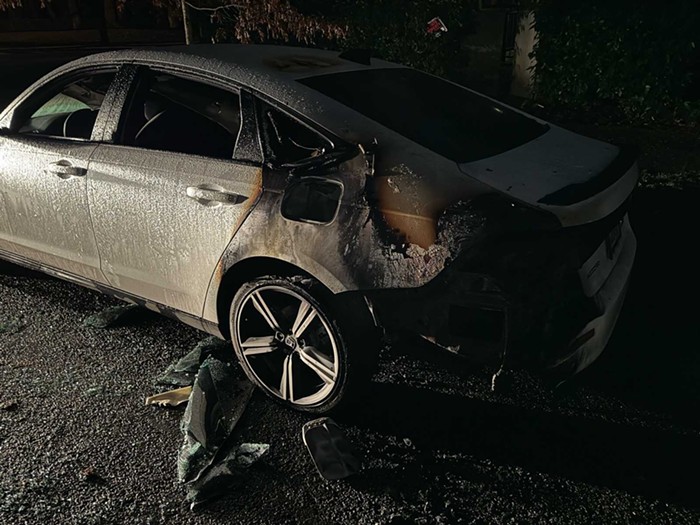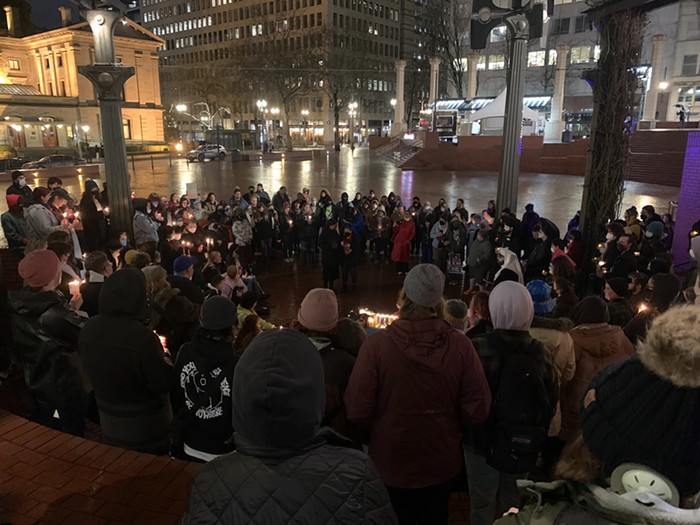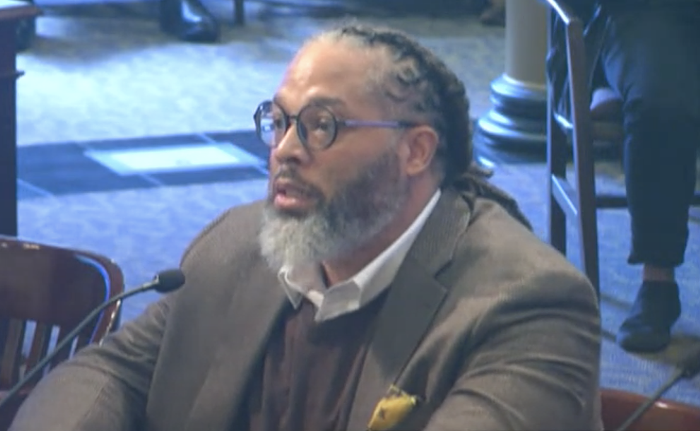THE HAND SANITIZER-FUELED Bunsen burner was a form of streetwise ingenuity to make MacGyver proud—but it may have cost a life.
When the body of Rachael Edwards was found in Oregon City on November 8, investigators found the makeshift stove nearby: a soda can with the top removed and filled with flammable hand sanitizer. When ignited, the device heated a can of soup on a metal rack and warmed a tiny shelter made of cardboard and covered by black plastic.
Authorities are still investigating the blaze that might have claimed Edwards’ life, and a fire official cautioned that a cause of death has not yet been determined. But the fire—and what one investigator calls the “pretty primitive” device found nearby—underscores a reality: As Portland prepares for what might be another dangerous winter, the region’s growing homeless population is often forced to employ dangerous strategies for staying warm.
One year after a cold snap left four dead from exposure on local streets, authorities are scrambling to open new winter shelters and convince landlords to take in homeless families. In the meantime, those seeking refuge in tents and lean-tos say they stay alive any way they can.
Fires classified by Portland Fire & Rescue as “homeless-related” are expensive. Data provided to the Mercury shows the cost of 218 homeless-related fires in the year after the September 1, 2016 sweep of the Springwater Corridor ballooned to $1.39 million—much of that because of a homeless-related fire at the International School in Southwest Portland that cost more than $900,000.
The fire bureau’s data says nothing about cause, but individuals living in homeless camps in Portland say they regularly use a wide variety of cheap accelerants as a way to stay warm as temperatures drop.
“There’s lots of ways to get warm, but not to stay warm,” said Michaeldean, interviewed November 19 outside his tent. Michaeldean and his wife use propane heaters, “hobo” candles (a cardboard wick in a wax-filled can), charcoal briquettes, and hand sanitizer. The night before, he bartered with a friend for a propane tank that helped stave off temperatures in the 40s for five hours.
Michaeldean still has facial scar tissue from an injury he sustained at age 14 in a 1992 Southeast Portland fire. He almost died while trying to rescue his 10-year-old brother from a burning apartment. Now, Michaeldean is more cautious than many who live at the intersection of the Springwater Corridor and I-205 multiuse path.
“In here, every damn thing’s flammable,” he said, pointing to 40 or 50 nearby dwellings. “People are going to have to find a way to keep warm. They’re going to do stupid shit. There are 1,000 ways to die.”
Often homeless people warming themselves by unsafe means are at greatest risk. Still, some fires pose a clear threat to the public, as in a recent incident in the Pearl District.
“Woken up by a big fire alarm at 5 am because a hobo set off a fire in our stairwells,” Portland resident Greg Koenig tweeted October 28. “Only a spectacular asshole sets fire in a high rise.”
Woken up by a big fire alarm at 5am because a hobo set off a fire in our stairwells. Only a spectacular asshole sets fire in a high rise
— Greg Koenig (@gak_pdx) October 28, 2017
Koenig lives in the same 10-story building that contains REI. He’s on the building’s board and has access to security reports that include what he calls “nefarious activity,” especially in the parking garage.
“Modern high-rise construction is absurdly fire-resistant,” Koenig wrote in a message to the Mercury. “PF&R is one of the country’s best fire departments and their best station is three blocks away. It is still really worrisome that someone would attempt to set a fire in a building full of people, especially in the fire escape routes.”
Koenig says getting the attention of fire investigators has been hard.
“Individual officers are great, but obviously overwhelmed. It seems the only way to get a response from the city is to repeatedly attempt to be the squeakiest of wheels.”
Portland fire officials didn’t respond to questions about the status of the investigation into the Pearl District or International School fires, and it’s not clear whether intentionally set “homeless-related” fires are becoming more prevalent. Data provided by the fire bureau doesn’t specifically include the cause of each fire, even though the Mercury requested that information.
“Portland Fire is a response organization; we’re preventative when it comes to residential and commercial properties, but as far as trying to prevent [homeless-related fires], it’s tough,” said fire Lt. Tommy Schroeder.
The two top classifications for homeless-related fires from September 2016 through August 2017 were “special outside fire,” and “outside rubbish fire.” The fires occurred at a regular clip during the year after the Springwater sweep, particularly in Southeast Portland. The single worst incident involving property loss was a dumpster fire that spread to the International School in Southwest Portland and cost $901,000.
Other notable homeless-related fires and the “value lost” for each:
• An October 24, 2016 structure fire near the Springwater Corridor: $35,000.
• A December 23, 2016 residential structure fire near Powell Butte: $60,000.
• A January 5, 2017 fire at the riverside Temco grain elevator by the Broadway Bridge: $50,000.
• A June 27, 2017 residential structure fire on Southeast Holgate near I-205 in the Lents neighborhood: $160,000.
As temperatures drop, local officials have put into place multi-tiered severe-weather shelter plans and opened new shelters, including a just-announced 75-bed space downtown.
Inside tents and lean-tos, though, people say they’re staying warm using items purchased at dollar stores, gleaned from the urban wilderness, or stolen. The long list includes hand sanitizer, “hobo” candles, propane, charcoal barbecue grills, open-pit campfires, kerosene, the canned cooking fuel Sterno, and other alcohol-based propellants.
“Two good-sized [candles] will heat up a tent like this pretty well,” said Datia Guthrie, 52, who sleeps in a small nylon tent. Guthrie buys her candles from Dollar Tree, and burns them underneath a plastic tarp she pulls over herself and her beagle while inside her tent.
Why the risk? Like nearly three-quarters of local unsheltered houseless people, Guthrie is disabled. The elements are not her only, or even greatest, threat.
“I just kissed death,” Guthrie said. “I just beat cancer. Now I’m skin and bones, have a hard time staying warm.”
The legality of the diverse heating methods being used by homeless people is unclear. Asked if the impromptu hand sanitizer-based “Bunsen burner” used in Rachael Edwards’ shanty was legal, the Clackamas Fire investigator paused.
“I don’t know,” he said. “Not a law I could cite right off.”
Marylou, 54, another person living in the Springwater and I-205 multiuse path camp, uses many of the methods for keeping warm described in this story, she said—plus the Mercury itself.
As Marylou put it: “I read your paper and then I burn it.”


















